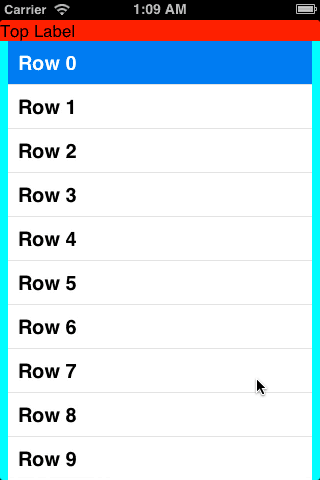首先,那些其他视图(表格视图的兄弟)是否严格位于表格视图的上方和下方?如果是这样,您是否考虑过让表格视图正常滚动,并将这些外部视图放在表格视图的页眉和页脚视图中?然后你不需要滚动视图。
其次,如果您还没有阅读技术说明 TN2154:UIScrollView 和 Autolayout ,则可能需要阅读。
第三,鉴于该技术说明中的信息,我可以想出几种方法来做你想做的事。最干净的可能是创建一个UITableView实现该intrinsicContentSize方法的子类。实现很简单:
@implementation MyTableView
- (CGSize)intrinsicContentSize {
[self layoutIfNeeded]; // force my contentSize to be updated immediately
return CGSizeMake(UIViewNoIntrinsicMetric, self.contentSize.height);
}
@end
然后让自动布局使用表格视图的内在内容大小。在滚动视图(包括表格视图)的子视图之间创建约束以进行布局,并确保滚动视图的所有四个边缘都有约束。
您可能需要invalidateIntrinsicContentSize在适当的时候发送到表视图(当您添加或删除行或更改行的高度时)。您可能只需覆盖适当的方法MyTableView即可。例如[self invalidateIntrinsicContentSize]在-endUpdates, -reloadData,- insertRowsAtIndexPaths:withRowAnimation:等中做。
这是我的测试结果:

滚动视图具有浅蓝色背景。顶部的红色标签和底部的蓝色标签是滚动视图内的表视图的兄弟姐妹。
这是我测试中视图控制器的完整源代码。没有xib文件。
#import "ViewController.h"
#import "MyTableView.h"
@interface ViewController () <UITableViewDataSource, UITableViewDelegate>
@end
@implementation ViewController
- (void)loadView {
UIView *view = [[UIView alloc] init];
self.view = view;
UIScrollView *scrollView = [[UIScrollView alloc] init];
scrollView.translatesAutoresizingMaskIntoConstraints = NO;
scrollView.backgroundColor = [UIColor cyanColor];
[view addSubview:scrollView];
UILabel *topLabel = [[UILabel alloc] init];
topLabel.translatesAutoresizingMaskIntoConstraints = NO;
topLabel.text = @"Top Label";
topLabel.backgroundColor = [UIColor redColor];
[scrollView addSubview:topLabel];
UILabel *bottomLabel = [[UILabel alloc] init];
bottomLabel.translatesAutoresizingMaskIntoConstraints = NO;
bottomLabel.text = @"Bottom Label";
bottomLabel.backgroundColor = [UIColor blueColor];
[scrollView addSubview:bottomLabel];
UITableView *tableView = [[MyTableView alloc] initWithFrame:CGRectZero style:UITableViewStylePlain];
tableView.translatesAutoresizingMaskIntoConstraints = NO;
tableView.dataSource = self;
tableView.delegate = self;
[scrollView addSubview:tableView];
UILabel *footer = [[UILabel alloc] initWithFrame:CGRectMake(0, 0, 200, 30)];
footer.backgroundColor = [UIColor greenColor];
footer.text = @"Footer";
tableView.tableFooterView = footer;
NSDictionary *views = NSDictionaryOfVariableBindings(
scrollView, topLabel, bottomLabel, tableView);
[view addConstraints:[NSLayoutConstraint
constraintsWithVisualFormat:@"V:|[scrollView]|"
options:0 metrics:nil views:views]];
[view addConstraints:[NSLayoutConstraint
constraintsWithVisualFormat:@"H:|[scrollView]|"
options:0 metrics:nil views:views]];
[view addConstraints:[NSLayoutConstraint
constraintsWithVisualFormat:@"V:|[topLabel][tableView][bottomLabel]|"
options:0 metrics:nil views:views]];
[view addConstraints:[NSLayoutConstraint
constraintsWithVisualFormat:@"H:|[topLabel]|"
options:0 metrics:nil views:views]];
[view addConstraints:[NSLayoutConstraint
constraintsWithVisualFormat:@"H:|-8-[tableView]-8-|"
options:0 metrics:nil views:views]];
[view addConstraint:[NSLayoutConstraint
constraintWithItem:tableView attribute:NSLayoutAttributeWidth
relatedBy:NSLayoutRelationEqual
toItem:view attribute:NSLayoutAttributeWidth
multiplier:1 constant:-16]];
[view addConstraints:[NSLayoutConstraint
constraintsWithVisualFormat:@"H:|[bottomLabel]|"
options:0 metrics:nil views:views]];
}
- (NSInteger)tableView:(UITableView *)tableView numberOfRowsInSection:(NSInteger)section {
return 20;
}
- (UITableViewCell *)tableView:(UITableView *)tableView cellForRowAtIndexPath:(NSIndexPath *)indexPath {
UITableViewCell *cell = [tableView dequeueReusableCellWithIdentifier:@"Cell"];
if (!cell) {
cell = [[UITableViewCell alloc] initWithStyle:UITableViewCellStyleDefault reuseIdentifier:@"Cell"];
}
cell.textLabel.text = [NSString stringWithFormat:@"Row %d", indexPath.row];
return cell;
}
@end
